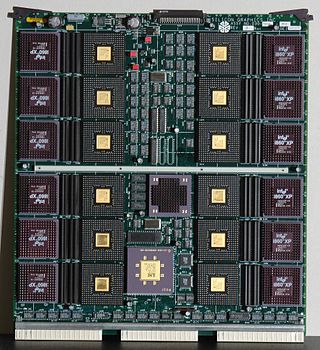Related Research Articles

Silicon Graphics, Inc. was an American high-performance computing manufacturer, producing computer hardware and software. Founded in Mountain View, California, in November 1981 by James Clark, its initial market was 3D graphics computer workstations, but its products, strategies and market positions developed significantly over time.

A workstation is a special computer designed for technical or scientific applications. Intended primarily to be used by a single user, they are commonly connected to a local area network and run multi-user operating systems. The term workstation has been used loosely to refer to everything from a mainframe computer terminal to a PC connected to a network, but the most common form refers to the class of hardware offered by several current and defunct companies such as Sun Microsystems, Silicon Graphics, Apollo Computer, DEC, HP, NeXT, and IBM which powered the 3D computer graphics revolution of the late 1990s.

The SGI Indigo2 and the SGI Challenge M are Unix workstations which were designed and sold by SGI from 1992 to 1997.

The DECstation was a brand of computers used by DEC, and refers to three distinct lines of computer systems—the first released in 1978 as a word processing system, and the latter two both released in 1989. These comprised a range of computer workstations based on the MIPS architecture and a range of PC compatibles. The MIPS-based workstations ran ULTRIX, a DEC-proprietary version of UNIX, and early releases of OSF/1.

The Octane series of IRIX workstations was developed and sold by SGI in the 1990s and 2000s. Octane and Octane2 are two-way multiprocessing-capable workstations, originally based on the MIPS Technologies R10000 microprocessor. Newer Octanes are based on the R12000 and R14000. The Octane2 has three improvements: a revised power supply, system board, and Xbow ASIC. The Octane2 has VPro graphics and supports all the VPro cards. Later revisions of the Octane include some of the improvements introduced in the Octane2. The codenames for the Octane and Octane2 are "Racer" and "Speedracer" respectively.
The Indy, code-named "Guinness", is a low-end multimedia workstation introduced on July 12, 1993 by Silicon Graphics Incorporated (SGI). SGI developed, manufactured, and marketed Indy as the lowest end of its product line, for computer-aided design (CAD), desktop publishing, and multimedia markets. It competed with Intel x86 computers, and with Windows and Macintosh, including using their files and running their applications via software emulation. It is the first computer to come standard with a video camera, called IndyCam.

The SGI Tezro is a series of high-end computer workstations sold by SGI from 2003 until 2006. Using MIPS CPUs and running IRIX, it is the immediate successor to the SGI Octane line. The systems were produced in both rack-mount and tower versions, and the series was released in June 2003 with a list price of US$20,500. The Tezro was released alongside the SGI Onyx4 and rack-mountable Tezros share many components with it, including plastic skins. The rack-mounted Tezros are functionally very similar to an Infinite Performance-equipped SGI Onyx350. Tezro marked the return of the original cube logo to SGI machines.

The O2 is an entry-level Unix workstation introduced in 1996 by Silicon Graphics, Inc. (SGI) to replace their earlier Indy series. Like the Indy, the O2 uses a single MIPS microprocessor and was intended to be used mainly for multimedia. Its larger counterpart is the SGI Octane. The O2 was SGI's last attempt at a low-end workstation.
The Indigo, introduced as the IRIS Indigo, is a line of workstation computers developed and manufactured by Silicon Graphics, Inc. (SGI). SGI first announced the system in July 1991.
Elan Graphics is a computer graphics architecture for Silicon Graphics computer workstations. Elan Graphics was developed in 1991 and was available as a high-end graphics option on workstations released during the mid-1990s as part of the Express Graphics architectures family. Elan Graphics gives the workstation real-time 2D and 3D graphics rendering capability similar to that of even high-end PCs made over ten years after Elan's introduction, with the exception of texture mapping, which had to be performed in software.
Extreme Graphics is a computer graphics architecture for Silicon Graphics computer workstations. Extreme Graphics was developed in 1993 and was available as a high-end graphics option on workstations such as the Indigo2, released during the mid-1990s. Extreme Graphics gives the workstation real-time 2D and 3D graphics rendering capability similar to that of even high-end PCs made many years after Extreme's introduction, with the exception of texture rendering which is performed in software. Extreme Graphics systems consist of eight Geometry Engines and two Raster Engines, twice as many units as the Elan/XZ graphics used in the Indy, Indigo, and Indigo2. The eight geometry engines are rated at 256 MFLOPS maximum, far faster than the MIPS R4400 CPU used in the workstation.

The IRIS Crimson is a Silicon Graphics (SGI) computer released in 1992. It is the world's first 64-bit workstation.
VPro, also known as Odyssey, is a computer graphics architecture for Silicon Graphics workstations. First released on the Octane2, it was subsequently used on the Fuel and Tezro workstations and the Onyx visualization systems, where it was branded InfinitePerformance.

DEC 3000 AXP was the name given to a series of computer workstations and servers, produced from 1992 to around 1995 by Digital Equipment Corporation. The DEC 3000 AXP series formed part of the first generation of computer systems based on the 64-bit Alpha AXP architecture. Supported operating systems for the DEC 3000 AXP series were DEC OSF/1 AXP and OpenVMS AXP.

SGI Onyx is a series of visualization systems designed and manufactured by SGI, introduced in 1993 and offered in two models, deskside and rackmount, codenamed Eveready and Terminator respectively. The Onyx's basic system architecture is based on the SGI Challenge servers, but with graphics hardware.
IrisVision is an expansion card developed by Silicon Graphics for IBM compatible PCs in 1991 and is one of the first 3D accelerator cards available for the high end PC market. IrisVision is an adaptation of the graphics pipeline from the Personal IRIS workstation to the Micro Channel architecture and consumer ISA buses of most modern PCs of the day. It has the first variant of IRIS GL ported to the PC, predating OpenGL.
The Origin 3000 and the Onyx 3000 is a family of mid-range and high-end computers developed and manufactured by SGI. The Origin 3000 is a server, and the Onyx 3000 is a visualization system. Both systems were introduced in July 2000 to succeed the Origin 2000 and the Onyx2 respectively. These systems ran the IRIX 6.5 Advanced Server Environment operating system. Entry-level variants of these systems based on the same architecture but with a different hardware implementation are known as the Origin 300 and Onyx 300. The Origin 3000 was succeeded by the Altix 3000 in 2004 and the last model was discontinued on 29 December 2006, while the Onyx 3000 was succeeded by the Onyx4 and the Itanium-based Prism in 2004 and the last model was discontinued on 25 March 2005.
The SGI IRIS series of terminals and workstations from Silicon Graphics was produced in the 1980s and 1990s. IRIS is an acronym for Integrated Raster Imaging System.

InfiniteReality refers to a 3D graphics hardware architecture and a family of graphics systems that implemented the aforementioned hardware architecture that was developed and manufactured by Silicon Graphics from 1996 to 2005. The InfiniteReality was positioned as Silicon Graphics' high-end visualization hardware for their MIPS/IRIX platform and was used exclusively in their Onyx family of visualization systems, which are sometimes referred to as "graphics supercomputers" or "visualization supercomputers". The InfiniteReality was marketed to and used by large organizations such as companies and universities that are involved in computer simulation, digital content creation, engineering and research.

RealityEngine is a 3D graphics hardware architecture and a family of graphics systems which was developed and manufactured by Silicon Graphics during the early to mid 1990s. RealityEngine was positioned as the company's high-end visualization hardware for its MIPS/IRIX platform. RealityEngine is designed for deployment exclusively within the company's Crimson and Onyx family of visualization systems, which are sometimes referred to as "graphics supercomputers" or "visualization supercomputers". The RealityEngine was marketed to large organizations, such as companies and universities that are involved in computer simulation, digital content creation, engineering and research.
References
- ↑ "Later (Newer) Indigo2 Technologies". Archived from the original on 2016-03-24. Retrieved 2016-04-13.
- ↑ "Impact graphics options by Gerhard Lenerz". Archived from the original on 2005-01-28. Retrieved 2016-04-13.
- ↑ "Octane Architecture" . Retrieved 2016-04-13.